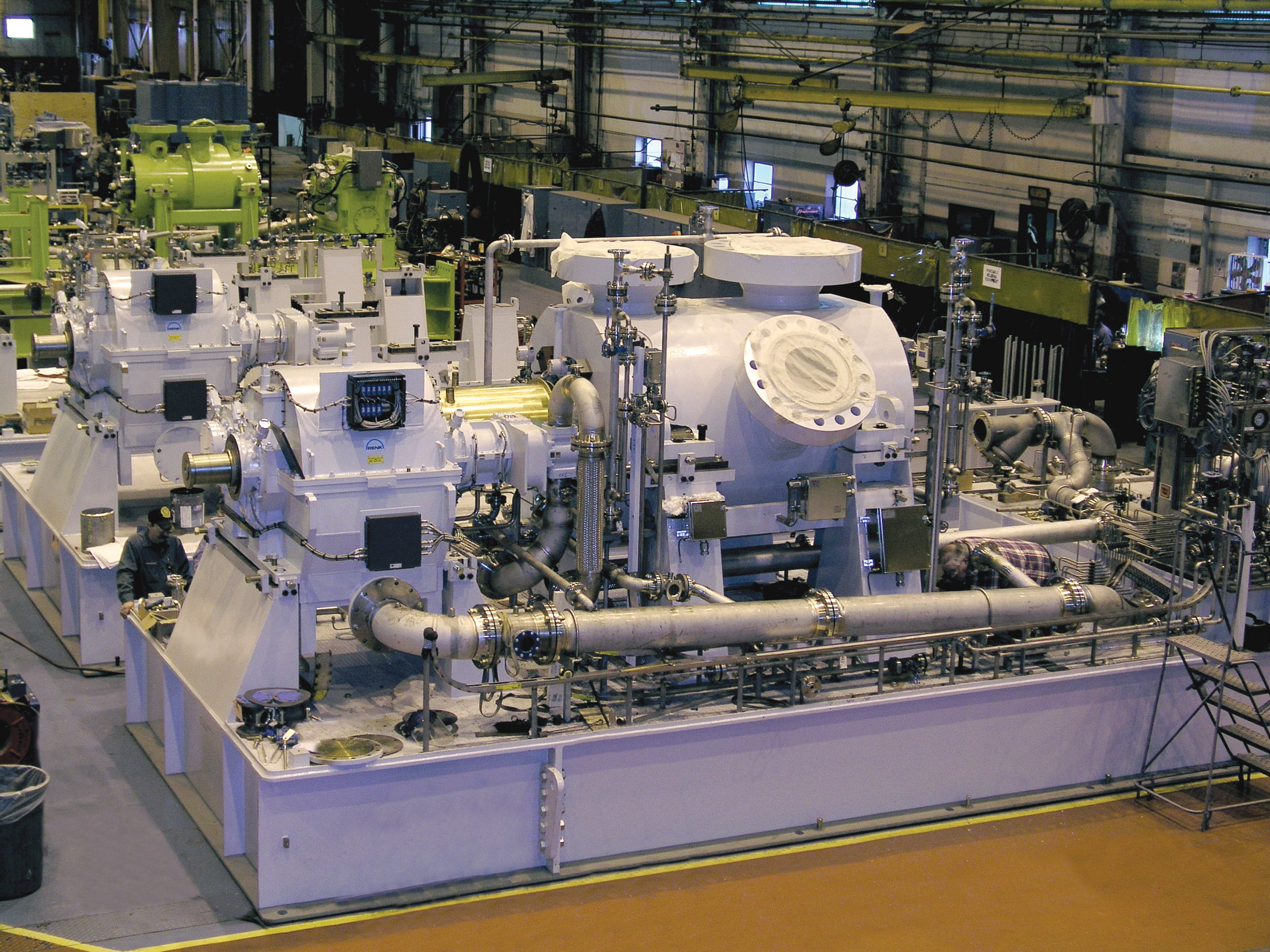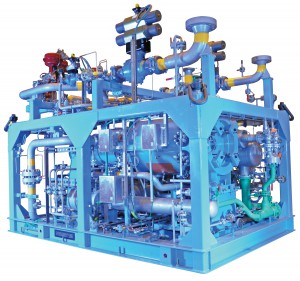February 2010 Vol. 237 No. 2
TechNotes
DATUM Centrifugal Compressor Line Sees Continuing Improvement (1)

Energy conversion technology has played a major role in the oil and gas industry for more than a century, and Dresser-Rand is an industry leader in designing, manufacturing and servicing centrifugal and reciprocating compressors, gas and steam turbines, expanders, rotating separators and control systems.
Since the early 1900s the company has built centrifugal compressors for applications as diverse and challenging as air, gas transmission, LNG, ethylene, refining, ammonia, gas production and gas reinjection for enhanced oil production.
One of D-R’s most significant technological advancements – the DATUM® centrifugal compressor – came nearly 15 years ago, and marked the beginning of a new era in compression solutions. Since the first offering, the DATUM D-16 unit, the product line has evolved to demonstrate superior efficiency, reduced emissions and the lowest life-cycle cost.
One of the most recent projects includes supplying six DATUM D14 centrifugal compressor packages driven by 52 MW gas turbines for Russia’s Nord Stream pipeline. Gazprom, the world’s largest gas company, is managing construction of a booster compression station in the 750-mile (1,200-km) pipeline project. As a new leg of an existing network, the Nord Stream pipeline will extend under the Baltic Sea from eastern Siberia to Germany and transport an estimated 55 billion cubic meters per year (Bcm/yr) of natural gas upon completion in 2012.
A similar application was completed in 2006 when the company provided DATUM centrifugal compression technology as part of the nearly $3.5 billion Dolphin Gas Project in the Middle East. Six DATUM units were installed with mechanical drive industrial dry low emission gas turbines to provide 2 Bcf/d through a nearly 250-mile (400-km) underwater pipeline from Ras Laffan, Qatar, to the Emirate of Abu Dhabi in the United Arab Emirates.
The upstream facilities were developed to extract wet gas from Qatar’s northern offshore oilfields and transport it through a pipeline to Ras Laffan. Once there, natural gas liquid (NGL) products and condensate would be stripped and the remaining dry gas compressed and transported along the sub-sea pipeline to the United Arab Emirates. The project is expected to supply natural gas to the region for the next 25 years.
To date, Dresser-Rand has sold more than 700 DATUM units for various applications worldwide. “The secret to the DATUM line’s success, and the reason for its growth globally, is flexibility,” said Jesus Pacheco, executive vice president New Equipment Sales Worldwide. “It doesn’t matter if the application requires moderate pressure or high pressure; the DATUM line can accommodate a 3,000 psi (207 bar) project just as well as an 1,800 psi (124 bar) project.”
The MEDGAZ sub-sea pipeline is one recent example of a DATUM pipeline compressor installation. The company supplied three high-efficiency DATUM compressor trains for the 130-mile (210 km) pipeline, planned to transport natural gas beneath the Mediterranean Sea from Beni Saf, Algeria, to Almeria, Spain.
The pipeline connects to the Albacete pipeline in Spain and is expected to transport an initial capacity of 8 Bcm of natural gas to European markets. The DATUM compressors raise the pressure from Algeria’s Hassi R’Mel natural gas field and supply the front-end gas boosting necessary to transport the natural gas via the underwater pipeline.
In applications requiring mul¬tiple compressor trains like Medgaz, the DATUM unit may handle the job with fewer trains compared to other manufacturers. This is because, in some applications, a single DATUM compressor can compress to greater pressure ratios per casing than a comparable existing product offering, resulting in the capability to handle the same pressure ratio with fewer compressor casings.

DATUM P multi-stage pipeline booster compressor builds on the company’s design approach, optimizing case and flowpath designs for pipeline applications.
The DATUM P pipeline compressor evolved from the modern DATUM technology. Designed for maximum performance in specified pressure and flow applications, the DATUM P compressor’s high efficiency, reliability, and ease of maintenance make it one of the most advanced turbocompressors available for the oil, gas, and process industries.
One key feature of the product line – including the DATUM P compressor – is its modular bundle assembly. This assembly enables rapid change-out of rotating elements – together with bearings, seals, and stationary components – in one cartridge-style assembly. The modular bundle allows a DATUM module to be replaced in the field, typically in less than a day, which greatly reduces main¬tenance shutdown periods and improves plant availability. This compares to a traditional design that could require a shutdown of more than five days.
One of the more recent DATUM P compressor projects included the installation of three DATUM D12P2 pipeline compressor units for Beijing Gas Transmission Company in China. Each unit, driven by an electric motor and speed increasing gear, was sized to compress 25 MMscm/d to a pressure of about 1,500 psia (103 bar) and required roughly 15,000 hp (11,185 kW).
These compressors were essential to increasing the flow of natural gas to Beijing, with daily consumption on the rise due to anti-air pollution efforts. Beijing has been encouraging people to use gas instead of coal for over a decade.
The DATUM compressor’s flexibility is apparent in its full range of gas compression appli¬cations – including some new ones such as acid gas (H2S + CO2 + H2O) and carbon capture and storage (CCS). One recent innovation, the DATUM C compressor, is an integrated, hermetically sealed unit that uses a high-speed motor driver with magnetic bearings. It is oil-free and has no shaft seals. It has no site emissions and offers a more compact footprint than any conventional centrifugal compressor with similar capabilities.
D-R supplied a DATUM C “compact” compressor package to Central New York Oil & Gas during last year’s heating season, and the system achieved its anticipated goals. The DATUM C centrifugal compressor is an integrated, electric motor-driven compressor designed for natural gas pipeline and process gas applications.

D-R’s DATUM C hermetically sealed, integral high-speed motor-driven compact compressor with magnetic bearings.
“Last winter, after ironing out some late developmental issues, the DATUM C compressor package performed as expected,” said Barry Cigich vice president of storage operations at Central New York Oil & Gas. “Having Dresser-Rand as our neighbor in Olean added a level of service that was crucial to our operating success.”
With no shaft seals exposed to the atmosphere, clients who need to compress highly toxic and lethal gases benefit from the hermetically sealed design. Like a common home refrigerator compressor, there is no leak path for the gas to escape. This “green” design also lends itself to unmanned remote operation that further enhances its safety and environmental friendliness.
The experience of DATUM C compressor laid the foundation for a new concept – the DATUM I integrated compres¬sion system (ICS). Suitable for upstream, midstream and downstream markets, in onshore, offshore and developing sub-sea applications, the system provides a compact, efficient means for removing liquid from a gas-liquid stream while increasing the pressure of the dehydrated outlet gas.
The ICS is engineered with centrifugal separator technology incorporated on the compressor rotor and packaged with process coolers, piping and valves. This concept can reduce the total footprint required by traditional modules by up to 50% and it cuts the weight by approximately 50%. The compressor remains dry and runs reliably at full performance.

DATUM ICS compressor.
As a quality-control measure, each DATUM I integrated compression system undergoes factory-testing at the company’s new, dedicated ICS test facility in Olean before delivery to the client as a fully assembled module. D-R recently tested its first production unit, to be used for boosting the gas-lift capacity of a semi-submersible platform which has been operating for more than 15 years in the Campos Basin, 69 miles (110 km) off the coast of Rio de Janeiro, Brazil.
Efficiency And Low Emissions
The superior efficiency of the DATUM compres¬sor reduces fuel consumption and lowers the emission of CO2 and Nox – an important ben¬efit because of increasing environmental and health concerns and more stringent regulations. When comparing the more than 700 DATUM compressors to traditional compres¬sors, the aggregate savings in fuel consumption and reduction in emissions, assuming a gas turbine driver, is nearly equivalent to 30 MMscf/d of natural gas and 1,450 metric tons a day of carbon dioxide emissions – similar to that of a conventional 1,600-MW coal-fired electric power plant.
For many applications, DATUM compressors often oper¬ate at 2-5% greater efficiencies, thereby reducing fuel consumption or increas¬ing throughput for each installed horsepower. Improved aerodynamic design and larger shaft diameter enable DATUM compressors to handle greater flows and pressure ratios for a given frame size. Several DATUM units have case pressure ratings of up to 10,500 psi (724 bar) and inlet flow rates of more than 100,000 cfm (16,990 cm/hr).
New families of impellers and matched stationary flow¬path components use the latest aerodynamic design and analysis technology and three-dimensional computational fluid dynamics. The company also developed new manufacturing techniques, such as single-piece impellers made from nickel-based super alloys, to withstand the corrosive effects of acid gas injected into the ground for environ¬mental protection.
The high efficiency of DATUM impellers permits gas to be compressed using less power. Often, a single DATUM unit can deliver pressure ratios that previ¬ously required multiple compressor bodies – resulting in a smaller footprint, reduced power consumption and the conservation of precious natural resources.
PDI: Another Pipeline Compressor Solution
While the DATUM compressor is ideal for large flow applications, it can’t take credit for Dresser-Rand’s largest single-stage pipeline compressor installation. The company recently provided a 46,000-hp Pipeline Direct Inlet (PDI) centrifugal compressor for a major North American gas transmission business.
A PDI is a single-stage, axial inlet compressor commonly used in natural gas pipeline service. These compressors use a direct inlet, overhung impeller and demonstrate flange-to-flange efficiencies to 90%. The PDI accommodates many drive configura¬tions in standard package designs.
Putting Products To The Test
Testing is the ultimate quality function, and Dresser-Rand’s capabilities at its high-power test facilities in Olean and Le Havre, France, have contributed greatly to the success of the DATUM line and other product groups. Clients can request ASME PTC 10 Type 2 tests using Dresser-Rand shop drivers or full-load, full-pressure testing and ASME PTC Type 1 hydrocarbon tests, to ensure successful field operation.
Last year the company completed con¬struction of its large compressor full-load test facility in Le Havre, increasing its worldwide testing capacity with natural gas up to 150 MW (gas turbine drive) or 100 MW (electrical drive). This facility includes a high-capacity quay with direct sea access.





Comments